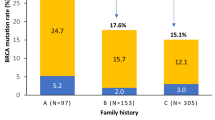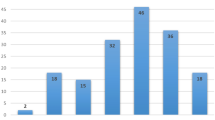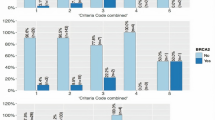Summary
The frequency, in women with breast cancer, of mutations and other variants in the susceptibility gene, BRCA1, was investigated using a population-based case–control-family study. Cases were women living in Melbourne or Sydney, Australia, with histologically confirmed, first primary, invasive breast cancer, diagnosed before the age of 40 years, recorded on the state Cancer Registries. Controls were women without breast cancer, frequency-matched for age, randomly selected from electoral rolls. Full manual sequencing of the coding region of BRCA1 was conducted in a randomly stratified sample of 91 cases; 47 with, and 44 without, a family history of breast cancer in a first- or second-degree relative. All detected variants were tested in a random sample of 67 controls. Three cases with a (protein-truncating) mutation were detected. Only one case had a family history; her mother had breast cancer, but did not carry the mutation. The proportion of Australian women with breast cancer before age 40 who carry a germline mutation in BRCA1 was estimated to be 3.8% (95% Cl 0.3–12.6%). Seven rare variants were also detected, but for none was there evidence of a strong effect on breast cancer susceptibility. Therefore, on a population basis, rare variants are likely to contribute little to breast cancer incidence.
Similar content being viewed by others
Article PDF
Change history
16 November 2011
This paper was modified 12 months after initial publication to switch to Creative Commons licence terms, as noted at publication
References
Bishop, D. T. & Hopper, J. L. (1997). AT-tributable risks?. Nature Genet 15: 226
Claus, E. B., Risch, N. & Thompson, W. D. (1991). Genetic analysis of breast cancer in the Cancer and Steroid Hormone Study. Am J Hum Genet 48: 232–242.
Clayton, D. & Hills, M. (1993). Statistical Models in Epidemiology. Oxford: Oxford University Press
Durocher, F., Shattuck-Eidens, D., McClure, M., Labrie, F., Skolnick, M. H., Goldgar, D. E. & Simard, J. (1996). Comparison of BRCA1 polymorphisms, rare sequence variants and/or missense mutations in unaffected and breast/ovarian cancer populations. Hum Mol Genet 5: 835–842.
Easton, D. (1997). Breast cancer genes – what are the real risks?. Nature Genet 16: 210–211.
Easton, D. F., Bishop, D. T., Ford, D. & Crockford, G. P., the Breast Cancer Linkage Consortium (1993). Genetic linkage analysis in familial breast and ovarian cancer: results from 214 families. Am J Hum Genet 52: 678–701.
Easton, D. F., Mathews, F. E. & Ford, D. (1996). Cancer mortality in relatives of women with ovarian cancer: the OPCS study. Int J Cancer 65: 284–294.
Ford, D., Easton, D. F., Bishop, D. T., Narod, S. A. & Goldgar, D. E., the Breast Cancer Linkage Consortium (1994). Risks of cancer in BRCA1-mutation carriers. Breast Cancer Linkage Consortium. Lancet 343: 692–695.
Ford, D., Easton, D. F. & Peto, J. (1995). Estimates of the gene frequency ofBRCA1and its contribution to breast and ovarian cancer incidence. Am J Hum Genet 57: 1457–1462.
Friedman, L. S., Ostermeyer, E. A., Szabo, C. I., Dowd, P., Lynch, E. D., Rowell, S. E. & King, M. C. (1994). Confirmation of BRCA1 by analysis of germline mutations linked to breast and ovarian cancer in ten families. Nature Genet 8: 399–404.
Hacia, J. G., Brody, L. C., Chee, M. S., Fodor, S. P. & Collins, F. S. (1996). Detection of heterozygous mutations in BRCA1 using high density oligonucleotide arrays and two-colour fluorescence analysis. Nature Genet 14: 441–447.
Hogervorst, F. B., Cornelis, R. S., Bout, M., Van Vliet, M., Oosterwijk, J. C., Olmer, R., Bakker, B., Klijn, J. G., Vasen, H. F. & Meijers Heijboer, H. (1995). Rapid detection of BRCA1 mutations by the protein truncation test. Nature Genet 10: 208–212.
Hopper, J. L. & Carlin, J. B. (1992). Familial aggregation of a disease consequent upon correlation between relatives in a risk factor measured on a continuous scale. Am J Epidemiol 136: 1138–1147.
Hopper, J. L., Giles, G. G., McCredie, M. R. E. & Boyle, P. (1994). Background, rationale and protocol for a case–control-family study of breast cancer. Breast 3: 79–86.
Langston, A. A., Malone, K. E., Thompson, J. D., Daling, J. R. & Ostrander, E. A. (1996). BRCA1 mutations in a population-based sample of young women with breast cancer. New Engl J Med 334: 137–142.
McCredie, M. R. E., Dite, G. S., Giles, G. G. & Hopper, J. L. (1998). Breast cancer in Australian women under the age of 40. Cancer Causes Control 9: 189–198.
Miki, Y., Swensen, J., Shattuck-Eidens, D., Futreal, P. A., Harshman, K., Tavtigian, S., Liu, Q., Cochran, C., Bennett, L. M., Ding, W., Bell, R., Rosenthal, J., Hussey, C., Tran, T., McClure, M., Frye, C., Hattier, T., Phelps, R., Haugenstrano, A., Katcher, H., Yakumo, K., Gholami, Z., Shaffer, D., Stone, S., Bayer, S. & Skolnick, M. (1994). A strong candidate for the 17q-linked breast and ovarian cancer susceptibility gene BRCA1. Science 266: 66–71.
Newman, B., Mu, H., Butler, L. M., Millikan, R. C., Moorman, P. G. & King, M-C (1998). Frequency of breast cancer attributable to BRCA1 in a population-based series of European–American and African–American women. JAMA 279: 915–921.
Peto, J., Easton, D. F., Mathews, F. E., Ford, D. & Swerdlow, A. J. (1996). Cancer mortality in relatives of women with breast cancer: the OPCS study. Int J Cancer 65: 275–283.
Roest, P. A., Roberts, R. G., Sugino, S., van Ommen, G. J. & den Dunnen, J. T. (1993). Protein truncation test (PTT) for rapid detection of translation-terminating mutations. Hum Mol Genet 2: 1719–1721.
Shattuck-Eidens, D., McClure, M., Simard, J., Labrie, F., Narod, S., Couch, F., Hoskins, K., Weber, B., Castilla, L., Erdos, M., Brody, L., Friedman, L., Ostermeyer, E., Szabo, C., King, M. C., Jhanwar, S., Offit, K., Norton, L., Gilewski, T., Lubin, M., Osborne, M., Black, D., Boyd, M., Steel, M., Ingles, S. & Goldgar, D. E. (1995). A collaborative survey of 80 mutations in the BRCA1 breast and ovarian cancer susceptibility gene. Implications for presymptomatic testing and screening. JAMA 273: 535–541.
Simard, J., Tonin, P., Durocher, F., Morgan, K., Rommens, J., Gingras, S., Samson, C., Leblanc, J. F., C, B. & Dion, F. (1994). Common origins of BRCA1 mutations in Canadian breast and ovarian cancer families. Nature Genet 8: 392–398.
Southey, M. C., Batten, L. E., McCredie, M. R. E., Giles, G. G., Dite, G., Hopper, J. L. & Ventor, D. J. (1998). Estrogen receptor polymorphism at codon 325 and risk of breast cancer before the age of 40. J Natl Cancer Inst 90: 532–536.
Struewing, J. P., Hartge, P., Wacholder, S., Baker, S. M., Berlin, M., McAdams, M., Timmerman, M. M., Brody, L. C. & Tucker, M. A. (1997). The risk of cancer associated with the 185delAG and 5382insC mutations of BRCA1 and the 6174delT mutation of BRCA2 among Ashkenazi Jews. New Engl J Med 336: 1401–1408.
Whittemore, A. S., Gong, G. & Itnyre, J. (1997). Prevalence and contribution of BRCA1 mutations in breast cancer and ovarian cancer: results from three US population-based case–control studies of ovarian cancer. Am J Hum Genet 60: 496–504.
Wooster, R., Bignell, G. & Lancaster, J.et al (1995). Identification of the breast cancer susceptibility gene BRCA2 . Nature 378: 789–792.
Author information
Authors and Affiliations
Rights and permissions
From twelve months after its original publication, this work is licensed under the Creative Commons Attribution-NonCommercial-Share Alike 3.0 Unported License. To view a copy of this license, visit http://creativecommons.org/licenses/by-nc-sa/3.0/
About this article
Cite this article
Southey, M., Tesoriero, A., Andersen, C. et al. BRCA1 mutations and other sequence variants in a population-based sample of Australian women with breast cancer. Br J Cancer 79, 34–39 (1999). https://doi.org/10.1038/sj.bjc.6690008
Received:
Revised:
Accepted:
Published:
Issue date:
DOI: https://doi.org/10.1038/sj.bjc.6690008
Keywords
This article is cited by
-
Increased genomic burden of germline copy number variants is associated with early onset breast cancer: Australian breast cancer family registry
Breast Cancer Research (2017)
-
Tumour morphology predicts PALB2 germline mutation status
British Journal of Cancer (2013)
-
BRCA1 and BRCA2 germline mutations in 85 Iranian breast cancer patients
Familial Cancer (2012)
-
Morphological predictors of BRCA1 germline mutations in young women with breast cancer
British Journal of Cancer (2011)
-
FAN1 variants identified in multiple-case early-onset breast cancer families via exome sequencing: no evidence for association with risk for breast cancer
Breast Cancer Research and Treatment (2011)



